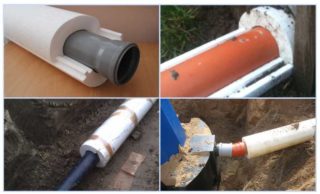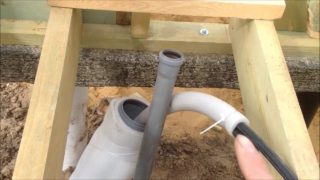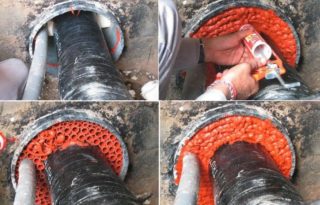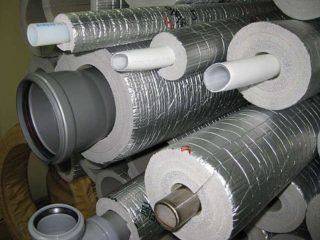Designing and laying a water supply system in a private house is only half the battle. When organizing water supply, it is important to provide for the protection of communications from freezing in the cold season. How to competently solve the problem of water pipe insulation, what materials and methods to choose and how to avoid mistakes in work, read on.
Why insulate outdoor water supply
Together with the freezing of the soil, the water circulating through the pipes will also freeze. In this case, the frozen liquid crystallizes and increases in volume by about 10%. This inevitably leads to pipe ruptures - both polypropylene and metal. In case of freezing, part of the pipeline will have to be replaced, since it cannot be repaired. Shut-off valves also suffer from frozen water, which will also need to be replaced.
The most vulnerable part of the system is entering the water pipe into the house, where condensation always forms. Therefore, high-quality insulation will additionally protect the house from dampness and help avoid unexpected costs associated with gusts.
How to protect the pipeline from freezing
If the water supply was laid at a shallow depth or passes above the ground, it is possible to carry out insulation in several ways.
Thermal insulation by pressure
The water in the pipes under high pressure changes its state of aggregation and does not turn into ice under the influence of frost.
How to implement the way:
- According to the manufacturer, check the pipes for resistance to high pressure - they must withstand up to 5 atm. The pipeline is carefully inspected to identify defects and damage that may impede the maintenance of the correct pressure.
- Embed a submersible pump into the system, which will provide high pressure. A receiver valve is mounted behind the pump, which prevents the backflow of water.
- On the installed receiver, turn off the tap and start the pump. When a high pressure level is reached, the device is turned off.
The disadvantage of this method is that the pipeline under high pressure cannot be used.
Heating cable
The outside heating cable will also have to be insulated with foamed polyethylene and expanded polystyrene. Heating will be sufficient only for the winter time or the period of severe frosts. Experts consider the method to be very effective, but the use of electricity for heating is always associated with additional costs.
Air insulation
The essence of the technique is to create an air gap between the pipe and the ground.A corrugated plastic pipe with a diameter of 20-25 cm larger than the main one is put on top of the water supply. The water in the pipeline has a positive temperature, therefore, by itself it will heat up the closed space "pipe in pipe", thereby providing protection against freezing.
Heat insulating paint
The construction market offers an innovative means for insulation - a pasty mass on a water or varnish basis with the addition of acrylic dispersion and fillers. The mixture is applied to the outer surface of the pipe by means of a spray gun in a layer of the desired thickness. Practice shows that heat-insulating paint applied in several layers can replace glass wool and even expanded polystyrene.
Materials for thermal insulation
- low thermal conductivity;
- durability;
- resistance to temperature extremes;
- fire safety;
- ease of installation.
At least 5 of the most popular insulation materials correspond to the specified characteristics.
Fiberglass
The well-known glass wool is a waste of glass production - thin fibers with a binder. This lightweight, non-flammable material, resistant to chemical attack and temperature changes, is available in the form of sheets or slabs. The only drawback of construction materials is increased moisture absorption, therefore, when arranging glass wool insulation, it needs waterproofing. The pipes are wrapped with a layer of glass wool, secured, and a waterproofing layer made of roofing material or glassine is installed on top.
Basalt wool
Expanded polystyrene
Insulating polystyrene foam (foam) is produced in the form of prefabricated casings or shells of a certain diameter. Installation is carried out independently - half of the shell is put on the pipe with an offset relative to each other and fixed with special tape. The joints are also insulated with tape, and shaped shells are used to insulate the turns and knots. Cylinders can be produced already with a layer of foil, which gives the material increased thermal insulation properties.
Penofol or isolon
Mineral wool
Mineral wool is a fibrous material obtained from rock melts, slags and mixtures thereof. Unlike glass wool, it is not hygroscopic, absorbing only 0.5% of moisture from the environment. The material is resistant to fire, biological and chemical factors - it does not burn or mold. The thermal insulation properties of mineral wool depend on the geometry of the fibers - it is recommended to choose varieties of material with randomly directed fiber.
The main mistakes in insulation
Rodent damage... Basalt wool as insulation is often damaged by ants and mice. Protection from insects and rodents will be provided by aluminum foil and a fine-mesh metal mesh - just wrap the pipes with them and fix them with reinforced tape.
Lack of integrity... When installing thermal insulation, all parts of the system must be carefully insulated.The slightest omissions can cause depressurization and lead to freezing of the water supply system.
Lack of tightness... Before arranging the heat-insulating layer, the pipeline should be carefully checked for defects and damage. The slightest leak can lead to freezing and pipe breakthrough.
Lack of insulation in the basement... The reason for a water supply breakthrough can be a low temperature not only outside, but also in unheated rooms. Therefore, it is necessary to take care of the organization of thermal insulation on the pipes in the basement and back rooms.
Winter work... The warm season allows for better insulation of the water supply system. In the summer, there is an opportunity to conduct a thorough analysis of the pipeline and slowly equip all the thermal insulation layers.













